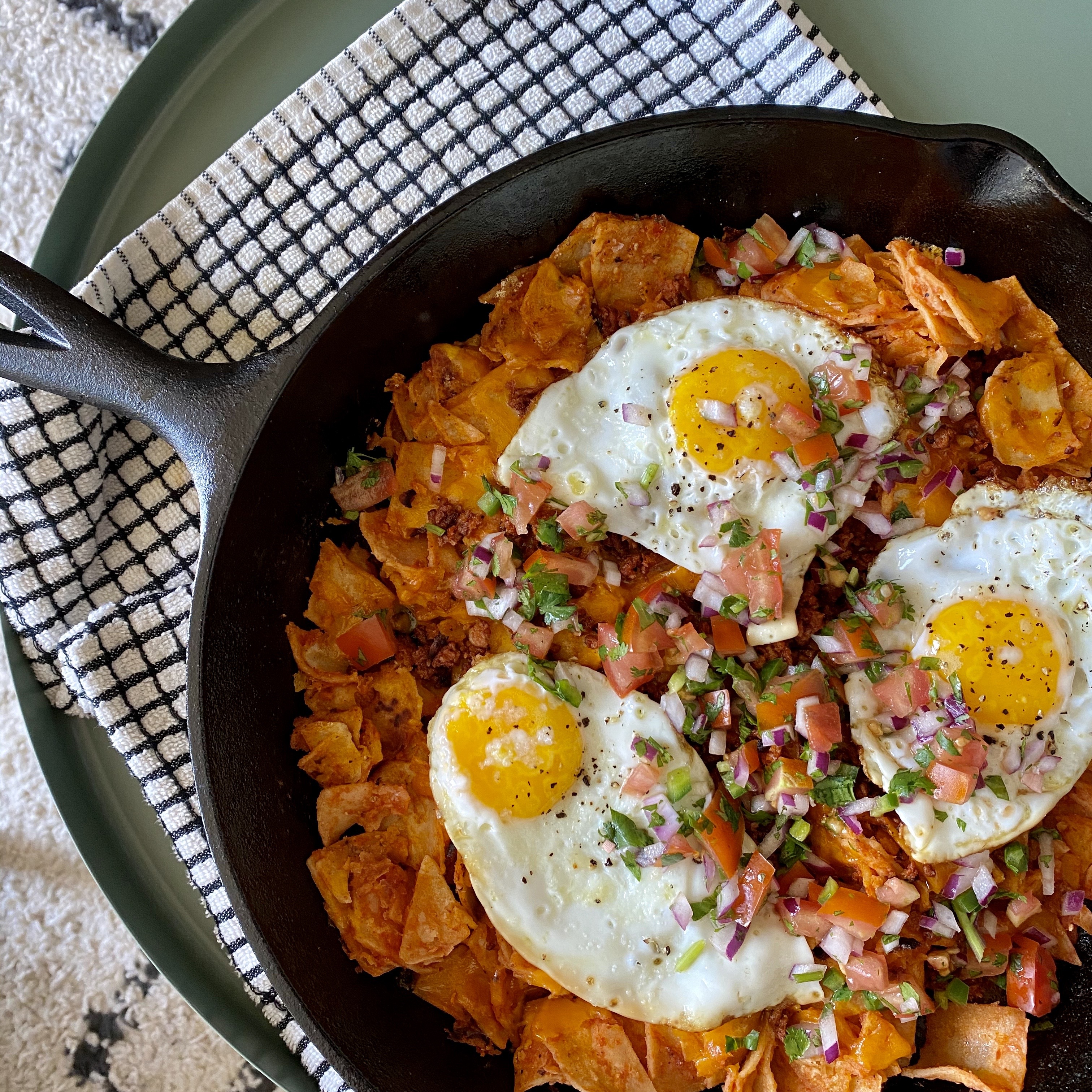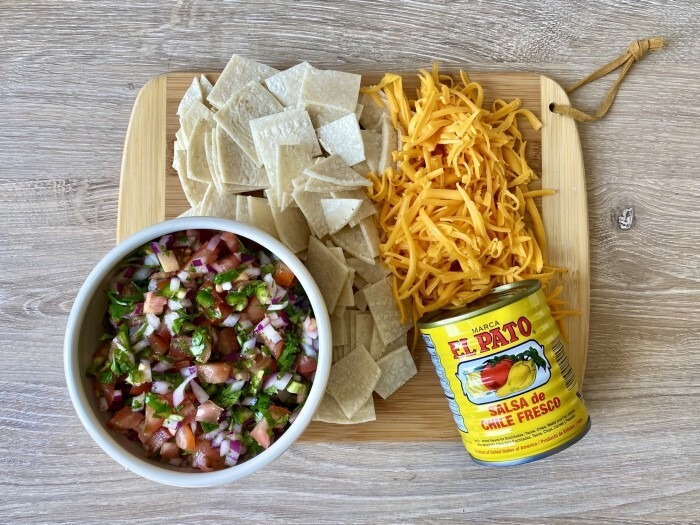
Historias de la Cocina: Chilaquiles
This Mexican breakfast has been saving stale tortillas from the garbage can for hundreds of years.
Over the last few years, I’ve been trying to reduce my food and plastic waste. I shop at zero-waste stores when possible, and have swapped out a number of household items like dish brushes and shower loofahs for plastic-less alternatives that can be composted at the end of their life. I also compost all food scraps that come out of my kitchen.
This lifestyle change has made me realize how much Mexican culture unconsciously reduces waste. Mexican culture, at least in the way I was raised, leaned more toward environmental friendliness than typical American culture. When I was a child, my grandparents frequently reused butter or cool-whip containers as tupperware, giving single-use plastic an extended life. New meals weren’t cooked until all leftovers were eaten, and often, dishes would be centered around products we already had in the house, so every grocery item bought was used. When I’d visit my non-Mexican friends’ homes for dinner, I’d often see them scraping uneaten food from dinner into the trash. In my house, leftovers were eaten by another family member, saved to eat another day, or repurposed for new meals. Corn grilled one day as a side dish with carne asada would be used in calabacitas (a sauteed zucchini and corn dish that is covered in cheese) the next. A large pot of beans would be used for days — for quesadillas, burritos or tostadas. But by far, my favorite meal that helped reduce food waste is a breakfast dish my mom made for me every weekend, called chilaquiles.
Chilaquiles — the perfect solution for tortillas that are no longer fresh enough to eat on their own — consist of cut up corn tortillas, lightly fried, sauteed with red or green salsa, cheese, and topped with a fried egg. The dish is best made with tortillas that have seen better days because they tend to crisp better.
The word chilaquiles comes from the Aztec Nahuatl word for chiles and greens. The dish itself was created to be made with leftover tortillas, highlighting the thriftiness of Mexican food culture. Recipes for chilaquiles in the United States have been dated back to 1898, where they were featured in Mexican-American chef Encarnación Pinedo’s cookbook “El Cocinera Español” (The Spanish Cook). “El Cocińera Español was the first cookbook written by a Hispanic writer in the U.S., and held the first recipes for Californio food: made by Spanish-speaking people born in California.
Where American kids had pancakes and bacon for Sunday morning breakfasts, I often had chilaquiles con huevo. Nearly every weekend, Mama would wake up around 11 a.m., pajamas still on, and head to the kitchen to fry tortillas and eggs for our weekly chilaquiles breakfast. The smell is unmistakable — savory, aromatic and a little tangy. The sound of tomato sauce hitting the pan with the fried tortillas and sizzling oil was enough to get me out of bed even on the laziest days. Chilaquiles were the perfect comfort food when I was a child, and now, they just might be the ideal breakfast after a night of one-too-many drinks.
I’ve had plenty of chilaquiles in restaurants, and almost every plate I’ve had has been prepared differently. Chilaquiles have a lot of room for variation and experimentation with ingredients, as long as the three staples are included in some way: corn tortillas, sauce and cheese. They can be prepared casserole style, layered in a dish and baked, or slow-cooked until the tortillas break down into a polenta-like porridge. The sauce can be rich and chile-laden like an enchilada sauce, or tomatillo-based, like salsa, and cheese can range from crumbly Mexican types (queso fresco or cotija) to shredded yellow cheeses (cheddar or colby jack).
Despite the large variety of cooking methods, in my eyes, nothing will ever quite top the simplicity of my mom’s Mexican-American breakfast dish. Avoiding a complicated and time-consuming sauce, Mama typically uses either canned Pato sauce (spicy Mexican tomato sauce) or regular tomato sauce after frying the tortillas. She lets them soak up the tangy spicy sauce for a moment, giving the dish a melty, chewy texture. When covered in shredded yellow cheese, and topped with a fried egg and fresh crema and salsa, the dish becomes savory, fatty, spicy and acidic in all the best ways.
When I make chilaquiles, I take Mama’s recipe one step further and add my favorite soy chorizo and a freshly made pico de gallo. The dish leans a little fatty and greasy, so the fresh component of the pico de gallo gives a great burst of acidity and brightness.
Feel free to use regular chorizo, shredded chicken or even pork carnitas to give the meal a little heft. Any salsa or tomato sauce will work, and cheeses can be substituted as well. This recipe is easy to riff off of.

Chilaquiles ingredients by Jae Thomas.
Chilaquiles
Yield: 4 servings
Time: 30 minutes
Ingredients
For the Chilaquiles
- 10-12 corn tortillas, cut into 1 inch squares
- 3 tbsp. neutral oil, like canola or vegetable oil for frying
- ⅔ cup Pato sauce or tomato sauce
- 3 oz. chorizo or soy chorizo (optional)
- ⅔ cup shredded cheddar or colby jack cheese
- Fried eggs, for serving (not optional, in my opinion)
- Crema, for serving (optional)
- Avocado, for serving (optional)
For the Pico de Gallo
- ½ yellow or red onion, finely diced
- ½ cup cilantro, leaves and tender stems, finely chopped
- 3 medium tomatoes, diced
- 1-2 jalapeños, seeds removed and finely diced
- 1 clove garlic, minced
- Juice of 1-2 limes
- ¼ Tsp cumin
- 1-2 pinches oregano (preferably Mexican)
- Salt, to taste
Pico de Gallo Preparation
Step 1
Add all ingredients to a bowl and mix until combined. Season to taste with salt.
Chilaquiles Preparation
Step 1
Heat oil in a large skillet over medium-high heat. Test the oil heat with a few drops of water. If the oil sputters a bit, the oil is hot enough to add the tortillas in. If the oil sputters a lot, your pan is too hot. Lower the heat and try again in a few minutes. Be sure when frying the tortillas that the oil is not too hot, or you’ll end up with tortilla chips instead of chilaquiles. The desired texture for the tortilla pieces is crispy edges with a soft middle.
Step 2
When the oil has reached the desired temperature, add in the tortillas. Cook for about 5-6 minutes, stirring occasionally, until the edges of most pieces have gotten slightly crispy. Do not over-mix, as the tortillas will break up too much.
Step 3
Lower heat to medium. Add in the chorizo after step 2 and stir fry until cooked through OR cook chorizo in a separate pan and add to the top when the dish is ready to be served.
Step 4
Lower heat to medium-low. Working quickly, add in Pato or tomato sauce, stirring only once or twice to coat the tortillas in sauce. Season with salt, pepper and garlic powder. Stir once more to distribute seasonings.
Step 5
Add cheese to tortilla mixture. When melted, top with fried eggs and pico de gallo, plus crema and avocado slices, if desired.


